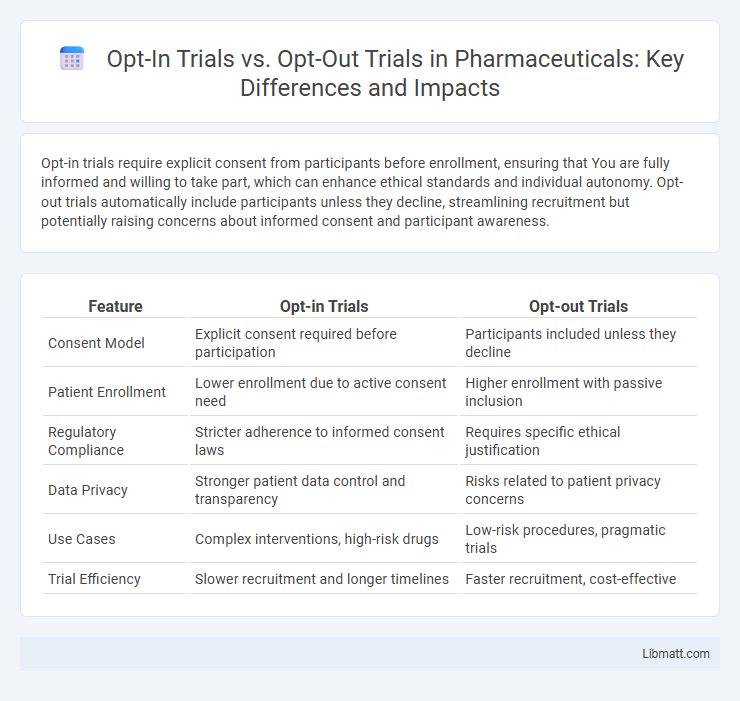Opt-in trials require explicit consent from participants before enrollment, ensuring that You are fully informed and willing to take part, which can enhance ethical standards and individual autonomy. Opt-out trials automatically include participants unless they decline, streamlining recruitment but potentially raising concerns about informed consent and participant awareness.
Table of Comparison
| Feature | Opt-in Trials | Opt-out Trials |
|---|---|---|
| Consent Model | Explicit consent required before participation | Participants included unless they decline |
| Patient Enrollment | Lower enrollment due to active consent need | Higher enrollment with passive inclusion |
| Regulatory Compliance | Stricter adherence to informed consent laws | Requires specific ethical justification |
| Data Privacy | Stronger patient data control and transparency | Risks related to patient privacy concerns |
| Use Cases | Complex interventions, high-risk drugs | Low-risk procedures, pragmatic trials |
| Trial Efficiency | Slower recruitment and longer timelines | Faster recruitment, cost-effective |
Understanding Opt-In and Opt-Out Trials
Opt-in trials require participants to actively provide consent before enrollment, ensuring explicit agreement and higher ethical standards in data collection. Opt-out trials automatically include participants unless they decline, increasing sample size but raising concerns about informed consent and potential bias. Understanding these differences is crucial for researchers to balance participant autonomy with study validity and regulatory compliance.
Key Differences Between Opt-In and Opt-Out Trials
Opt-in trials require explicit consent from participants before enrollment, ensuring higher participant autonomy and informed decision-making. In contrast, opt-out trials automatically include participants unless they actively decline, increasing sample size and reducing selection bias. Understanding these key differences helps tailor trial design to your study goals and ethical considerations.
Advantages of Opt-In Trial Designs
Opt-in trial designs ensure that participants provide explicit consent before enrollment, leading to higher ethical standards and respect for participant autonomy. These trials often result in a more engaged and compliant participant pool, which can improve data quality and reliability. Opt-in designs can enhance trust and transparency, fostering better relationships between researchers and participants.
Benefits of Opt-Out Trial Approaches
Opt-out trial approaches significantly increase participation rates by automatically enrolling individuals unless they decline, which enhances the representativeness and validity of the study outcomes. This method reduces selection bias, ensuring a more comprehensive data set that accurately reflects the target population. Your engagement in opt-out trials contributes to faster and more inclusive clinical research advancements.
Ethical Considerations in Opt-In vs Opt-Out Trials
Opt-in trials require explicit participant consent, ensuring respect for autonomy and informed decision-making, which strengthens ethical compliance but may reduce enrollment rates. Opt-out trials presume consent unless participants actively decline, potentially enhancing sample size and representativeness but raising concerns about participant awareness and informed choice. Ethical considerations center on balancing participant autonomy with research efficiency, necessitating transparent communication and robust safeguards in opt-out methodologies.
Impact on Participant Enrollment Rates
Opt-in trials often result in lower participant enrollment rates because individuals must actively give consent, creating an additional step that limits participation to those who are proactive. Opt-out trials significantly increase enrollment rates by automatically including participants unless they specifically decline, reducing barriers to entry. Your choice between opt-in and opt-out can dramatically influence the size and representativeness of the trial population.
Data Quality in Opt-In and Opt-Out Studies
Opt-in trials often yield higher data quality due to participants' active consent and engagement, which typically results in more accurate and reliable responses. Opt-out trials, while increasing sample size and representativeness, may face challenges in data quality because participants may be less informed or motivated, leading to potential noncompliance or incomplete data. Balancing data integrity and inclusivity remains a critical consideration in designing opt-in versus opt-out research methodologies.
Regulatory Perspectives on Consent Models
Regulatory perspectives on opt-in and opt-out trials emphasize the importance of informed consent to protect participant autonomy and ensure ethical standards. Opt-in trials require explicit consent, aligning closely with stringent regulations like GDPR and the Declaration of Helsinki, which prioritize clear, voluntary agreement from participants. Your choice between these models affects compliance risk and participant trust, with regulators increasingly scrutinizing opt-out approaches for potential ethical and legal vulnerabilities.
Case Studies: Opt-In vs Opt-Out in Practice
Case studies comparing opt-in and opt-out trials reveal significant differences in participant enrollment rates, with opt-out approaches consistently generating higher participation due to default inclusion unless you actively decline. Research conducted in organ donation and email marketing demonstrates that opt-out trials yield broader data sets and more representative outcomes, while opt-in trials often face selection bias from self-selected participants. Evaluating these practical examples helps determine which model maximizes efficiency and ethical considerations depending on the trial's objectives.
Choosing the Right Consent Model for Clinical Trials
Choosing the right consent model for clinical trials hinges on balancing participant autonomy with research efficiency. Opt-in trials require explicit consent from participants, ensuring higher ethical standards and informed participation but often result in lower enrollment rates. Opt-out trials presume consent unless participants decline, boosting recruitment and data representativeness, but they may raise concerns about informed consent and participant awareness.
Opt-in trials vs Opt-out trials Infographic

 libmatt.com
libmatt.com